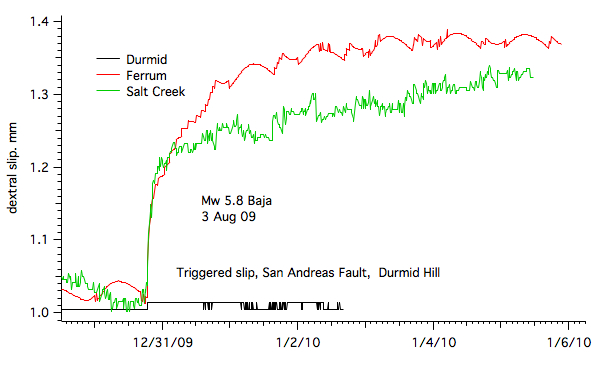Triggered Slip Durmid Hill
August 2009 -January 2010
click here for Slip triggered by the Baja 4 April Mw=7.2 earthquake
Two earthquakes resulted in an incremental offset of the surface San Andreas fault in 2009. The slip events were superficial and, unlike the spontaneous slip events of previous years, were not observed on the nearby laser strainmeters on Durmid Hill. The Mw6.9 Gulf of California earthquake on 3 August 2009 resulted in 0.7 mm of slip, and a M5.8 earthquake in Baja California on 30 Dec 2009 resulted 0.4 mm of slip. Background creep on the fault at all three locations during the period August 2009 to January 2010 amounted to 1.2mm-1.4 mm. The data have been partly corrected for thermoelastic effects, which are small on the graphite rods, but significant on the stainless steel instrument at Salt Creek. pdf

3 Aug 2009
Slip on the fault was impulsive at all three creepmeters and decayed with an initial time constant of roughly 2 hours. Amplitudes were similar at Salt Creek and Ferrum but were reduced by an order of magnitude on the southernmost site on the crest of the Hill south of Bat Cave Buttes. pdf
30 Dec 2009
Slip on the fault was was impulsive at Salt Creek and Ferrum decaying with an initial time constant of roughly 2 hours. No synchronous slip occurred at the southernmost site on the crest of the Hill south of Bat Cave Buttes.pdf

Precipitation
Rain moistened the surface of the hill starting 8 December 2009. Runoff was considerable and ponding in the fault zone (mud cracks visible in early January) was observed near the crest of the Hill. The effects of the rain (which propagated southwards) were to facilitate additional slip of 0.1 mm at Ferrum and Salt Creek, and to cause apparent left lateral slip of 0.05 mm at Durmid followed by zero slip on the fault for the following month.pdf
